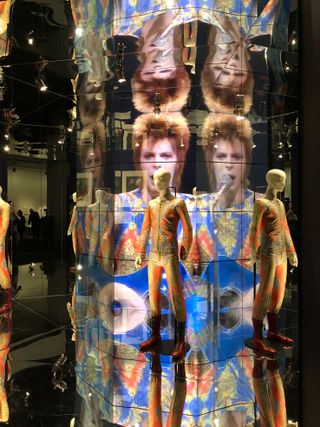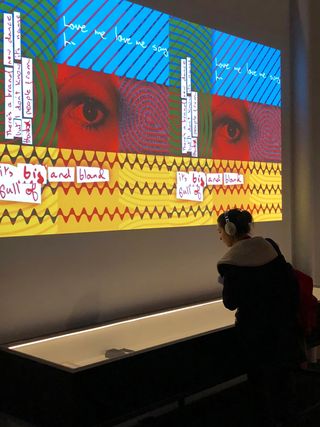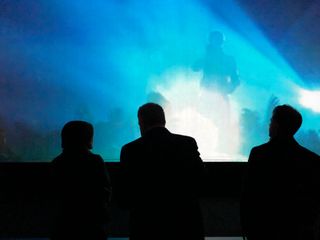One part theater, one part rock ‘n’ roll: if there’s ever been an icon whose life demanded an audiovisual presentation to sufficiently tell its story, it’s David Bowie. Making its final stop on a five-year global tour of more than a dozen cities at the Brooklyn Museum in New York from March 2 through July 15, “David Bowie Is” calls upon all manner of media to illustrate the incomparably protean persona of one of history’s most influential entertainers.

“We wanted it to be unlike any museum exhibition you’d ever been to before,” said Victoria Broackes, curator at London’s Victoria and Albert Museum, where the exhibition was first staged. “We wanted to bring something of Bowie’s own groundbreaking nature into the design concept of the exhibition. And thirdly, we wanted to make an exhibition in which the sound and vision would be considered as much a part of the story as more traditional objects such as photographs and costumes.”
To accomplish this, the Victoria and Albert Museum reached out to London-based creative audiovisual design firm 59 Productions in 2011 to formulate a plan. Originally responsible for the entire exhibition’s presentation, the firm’s responsibilities have been reduced to overseeing the audio and video design elements of the show in its current form; the overall layout in New York was spearheaded by Brooklyn Museum’s chief designer Matthew Yokobosky.
According to Broackes, the exhibition was envisioned from its inception as being non-biographical in nature; rather, it was meant to be an exploration of the inspiration and influences behind Bowie’s many artistic incarnations. This concept, Broackes relayed, was borne out of a passage Bowie wrote in 1999: “I’m interested in how artists work—the process. How they got where they got, why they’re like they are, how they do what they do. Those three things are what you want to find out about a person you admire.”

This nonlinearity necessitated a novel approach to the auditory component of the experience—and Sennheiser technology helps deliver it. When guests enter the exhibition, they are handed a pair of the company’s HD-1 over-ear headphones—a much higher fidelity implement than one might typically receive for a guided museum tour—and an accompanying lanyard-worn Sennhieser guidePORT receiver, into which the headphones are plugged.
Making their way from one station to the next, guests’ receivers automatically switch between the dozens of audio tracks linked to the various visual components—including videos displays, projection-mapped scenes, and artwork—allowing visitors the freedom to move about at their own pace, in any order they choose, without any action required on their part.
One thing visitors might notice in their journey is the varying fidelity of the audio tracks they hear as they move about: some feature pristine-quality mixes, while others are much more raw and aged, with hums and pops. According to Sennheiser’s Robert Genereux, who was responsible for the company’s technological contributions to the exhibition, this was intentional: “The creators wanted to use the original recordings, if they were available, to increase the authenticity of the experience,” he said.
In terms of visuals, the exhibition runs the gamut from live performances, to interviews in which Bowie discusses his creative and recording processes, to films in which he starred as an actor—and everything in between. The manner in which this content is presented varies with creative ingenuity: a projection-mapped likeness of a living room easy chair flashes collages of Bowie’s childhood photos; a mirror-lined chamber in the center atrium envelops a glam-costumed mannequin with rear-projected performance footage of Bowie in that outfit; a hall depicting his work in the 1980s features stacks of bulky CRT TVs playing television programs from that period.
The culmination of the tour is the exhibition’s audiovisual pièce de résistance, which transports visitors into the audience of David Bowie performances throughout the decades. Panasonic large-venue projectors display footage on a large cinema display in the center, as well as on two smaller screens on either side.

While visually impressive, the true immersion comes courtesy of the audio tracks, which have been upmixed into 3D tracks using Sennheiser’s AMBEO technology. This mix is then presented through nine Sennheiser Neumann speakers and four subwoofers positioned behind the front screen and at the back of the room, on two vertical planes. Beyond making for a sonically gratifying experience, this has an added advantage for a room full of people, Genereux pointed out: “There’s no hot spots; you can move around the room and it feels like you’re at a concert.”
Overall, the exhibition is successful, through its use of audiovisual technology, in providing visitors with a means of personally uncovering the artistic energy behind the man whom the exhibit’s designer Yokobosky called “our guide into new audio territories, and to new visual futures—our guide on a fantastic voyage.”













